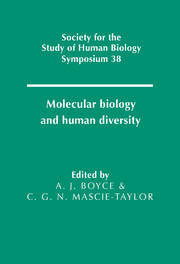Book contents
- Frontmatter
- Contents
- List of contributors
- Preface
- 1 Mitochondrial DNA in ancient and modern humans
- 2 Digital DNA typing of human paternal lineages
- 3 Minisatellites as tools for population genetic analysis
- 4 DNA fingerprinting: development of a technology and its application to the study of human populations
- 5 Kinship, inbreeding, and matching probabilities
- 6 Using the coalescent to interpret gene trees
- 7 Some attempts at measuring natural selection by malaria
- 8 AIDA: Geographical patterns of DNA diversity investigated by autocorrelation statistics
- 9 Mitochondrial DNA sequences in Europe: an insight into population history
- 10 Palaeolithic and neolithic contributions to the European mitochondrial gene pool
- 11 The molecular diversity of the Niokholo Mandenkalu from Eastern Senegal: an insight into West Africa genetic history
- 12 The peopling of Madagascar
- 13 Molecular perspectives on the colonisation of the Pacific
- 14 Population ancestry on Tristan da Cunha–the evidence of the individual
- 15 Linguistic divergence and genetic evolution: a molecular perspective from the New World
- 16 Allelic sequence diversity at the human β-globin locus
- 17 A nuclear perspective on human evolution
- 18 Contrasting gene trees and population trees of the evolution of modern humans
- 19 Methods and models for understanding human diversity
- Index
2 - Digital DNA typing of human paternal lineages
Published online by Cambridge University Press: 19 September 2009
- Frontmatter
- Contents
- List of contributors
- Preface
- 1 Mitochondrial DNA in ancient and modern humans
- 2 Digital DNA typing of human paternal lineages
- 3 Minisatellites as tools for population genetic analysis
- 4 DNA fingerprinting: development of a technology and its application to the study of human populations
- 5 Kinship, inbreeding, and matching probabilities
- 6 Using the coalescent to interpret gene trees
- 7 Some attempts at measuring natural selection by malaria
- 8 AIDA: Geographical patterns of DNA diversity investigated by autocorrelation statistics
- 9 Mitochondrial DNA sequences in Europe: an insight into population history
- 10 Palaeolithic and neolithic contributions to the European mitochondrial gene pool
- 11 The molecular diversity of the Niokholo Mandenkalu from Eastern Senegal: an insight into West Africa genetic history
- 12 The peopling of Madagascar
- 13 Molecular perspectives on the colonisation of the Pacific
- 14 Population ancestry on Tristan da Cunha–the evidence of the individual
- 15 Linguistic divergence and genetic evolution: a molecular perspective from the New World
- 16 Allelic sequence diversity at the human β-globin locus
- 17 A nuclear perspective on human evolution
- 18 Contrasting gene trees and population trees of the evolution of modern humans
- 19 Methods and models for understanding human diversity
- Index
Summary
The Y chromosome
The Y chromosome (for a review see Ellis, 1991) is an unusual part of the human genome; at about 60 million base pairs, it represents around 2% of the total, yet half of the human population survives quite happily without one. The Y is haploid and paternally inherited. The consequence of this haploidy is that, outside of two small pseudoautosomal regions at the tips of the short and long arms of the chromosome, which can recombine with the X (Rouyer et al., 1986; Freije, Helms, Watson & Donis-Keller, 1992), the Y has no chromosomal partner with which to recombine at meiosis. Thus the Y is passed down virtually intact from father to son. This is in contrast to the X chromosome and autosomes, which are continually being reshuffled by recombination, and means that a comparison of Y chromosomes is a direct comparison of individuals. As Y chromosomes pass down paternal lineages from a common paternal ancestor, they accumulate mutations; if we could look at these mutations, in the form of various kinds of DNA polymorphisms, we could firstly try to determine how modern Ys are related to each other and to their ancestors. Secondly, these polymorphisms define Y chromosome types, and if we could measure the frequencies of these types in different populations, we could also attempt to understand some aspects of the histories of these populations (Spurdle & Jenkins, 1992a).
- Type
- Chapter
- Information
- Molecular Biology and Human Diversity , pp. 12 - 23Publisher: Cambridge University PressPrint publication year: 1996
- 1
- Cited by



